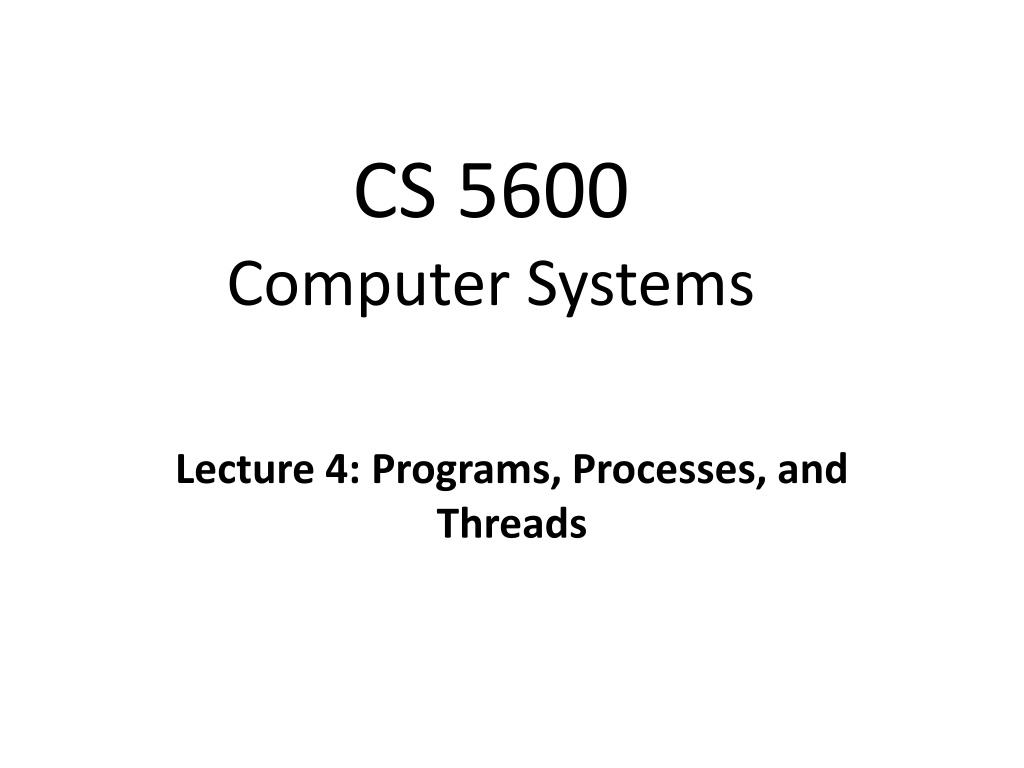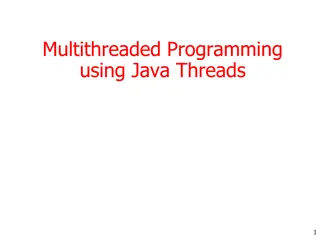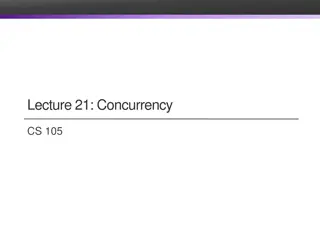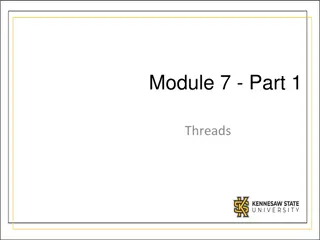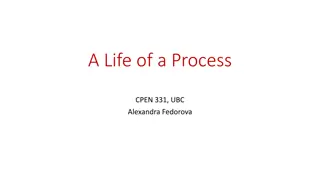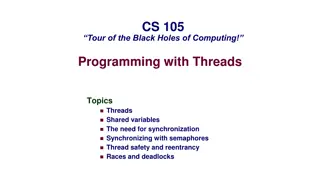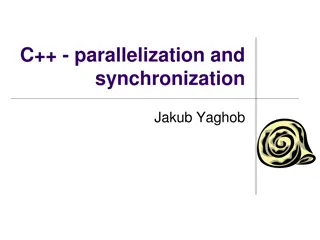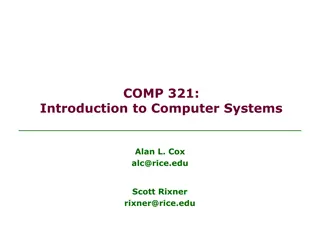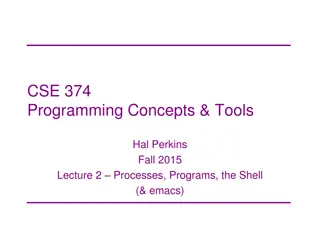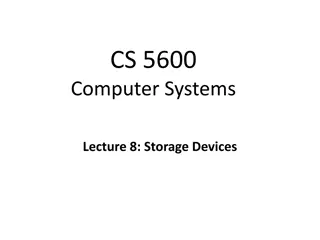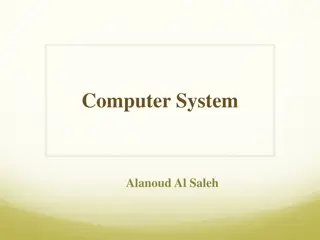Understanding Programs, Processes, and Threads in Computer Systems
In this comprehensive guide, we delve into the fundamental concepts of programs, processes, and threads in computer systems. Exploring topics such as dynamic code execution, program formats, and the execution of .exe files, we uncover the intricate workings of how software is executed and managed by operating systems. From the specific file formats programs adhere to, to the structure of ELF file formats, this resource provides a deep understanding of the key components within a computer system.
Download Presentation

Please find below an Image/Link to download the presentation.
The content on the website is provided AS IS for your information and personal use only. It may not be sold, licensed, or shared on other websites without obtaining consent from the author. Download presentation by click this link. If you encounter any issues during the download, it is possible that the publisher has removed the file from their server.
E N D
Presentation Transcript
CS 5600 Computer Systems Lecture 4: Programs, Processes, and Threads
Programs Processes Context Switching Protected Mode Execution Inter-process Communication Threads 2
Running Dynamic Code One basic function of an OS is to execute and manage code dynamically, e.g.: A command issued at a command line terminal An icon double clicked from the desktop Jobs/tasks run as part of a batch system (MapReduce) A process is the basic unit of a program in execution 3
Programs and Processes Process The running instantiation of a program, stored in RAM Program An executable file in long-term storage One-to-many relationship between program and processes 4
How to Run a Program? When you double-click on an .exe, how does the OS turn the file on disk into a process? What information must the .exe file contain in order to run as a program? 5
Program Formats Programs obey specific file formats CP/M and DOS: COM executables (*.com) DOS: MZ executables (*.exe) Named after Mark Zbikowski, a DOS developer Windows Portable Executable (PE, PE32+) (*.exe) Modified version of Unix COFF executable format PE files start with an MZ header. Why? Unix/Linux: Executable and Linkable Format (ELF) Mac OSX: Mach object file format (Mach-O) 6
test.c #include <stdio.h> int big_big_array[10 * 1024 * 1024]; char *a_string = "Hello, World!"; int a_var_with_value = 100; int main(void) { big_big_array[0] = 100; printf("%s\n", a_string); a_var_with_value += 20; printf("main is : %p\n", &main); return 0; } 7
ELF File Format ELF Header Contains compatibility info Entry point of the executable code Program header table Lists all the segments in the file Used to load and execute the program Section header table Used by the linker 8
ELF Header Format typedef struct { 1 5 10 15 } Elf32_Ehdr; unsigned char e_ident[EI_NIDENT]; Elf32_Half e_type; Elf32_Half e_machine; Elf32_Word e_version; Elf32_Addr e_entry; Elf32_Off e_phoff; Elf32_Off e_shoff; Elf32_Word e_flags; Elf32_Half e_ehsize; Elf32_Half e_phentsize; Elf32_Half e_phnum; Elf32_Half e_shentsize; Elf32_Half e_shnum; Elf32_Half e_shstrndx; ISA of executable code Entry point of executable code What should EIP be set to initially? Offset of program headers Offset of section headers # of program headers # of section headers 9
ELF Header Example $ gcc g o test test.c $ readelf --header test ELF Header: Magic: Class: Data: Version: OS/ABI: ABI Version: Type: Machine: Version: Entry point address: Start of program headers: Start of section headers: Flags: Size of this header: Size of program headers: Number of program headers: 9 Size of section headers: Number of section headers: Section header string table index: 33 7f 45 4c 46 02 01 01 00 00 00 00 00 00 00 00 00 ELF64 2's complement, little endian 1 (current) UNIX - System V 0 EXEC (Executable file) Advanced Micro Devices X86-64 0x1 0x400460 64 (bytes into file) 5216 (bytes into file) 0x0 64 (bytes) 56 (bytes) 64 (bytes) 36 10
Investigating the Entry Point int main(void) { printf("main is : %p\n", &main); return 0; } $ gcc -g -o test test.c $ readelf --headers ./test | grep Entry point' Entry point address: 0x400460 $ ./test Hello World! main is : 0x400544 11
Entry point != &main Most compilers insert extra code into compiled programs This code typically runs before and after main() $ ./test Hello World! main is : 0x400544 $ readelf --headers ./test | grep Entry point' Entry point address: 0x400460 $ objdump --disassemble M intel ./test 0000000000400460 <_start>: 400460: 31 ed 400462: 49 89 d1 400465: 5e 400466: 48 89 e2 400469: 48 83 e4 f0 40046d: 50 40046e: 54 40046f: 49 c7 c0 20 06 40 00 mov r8,0x400620 400476: 48 c7 c1 90 05 40 00 mov rcx,0x400590 40047d: 48 c7 c7 44 05 40 00 mov rdi,0x400544 400484: e8 c7 ff ff ff xor ebp,ebp mov r9,rdx pop rsi mov rdx,rsp and rsp,0xfffffffffffffff0 push rax push rsp call 400450 <__libc_start_main@plt> 12
Sections and Segments Multiple sections in one segments Sections are the various pieces of code and data that get linked together by the compiler Each segment contains one or more sections Each segment contains sections that are related E.g. all code sections Segments are the basic units for the loader Segments 13
Common Sections Sections are the various pieces of code and data that compose a program Key sections: .text Executable code .bss Global variables initialized to zero .data, .rodata Initialized data and strings .strtab Names of functions and variables .symtab Debug symbols 14
Section Example String variable .data Empty 10 MB array .bss int big_big_array[10*1024*1024]; char *a_string = "Hello, World!"; int a_var_with_value = 0x100; Initialized global variable .data int main(void) { big_big_array[0] = 100; printf("%s\n", a_string); a_var_with_value += 20; } String constant .rodata Code .text 15
$ readelf --headers ./test Section to Segment mapping: Segment Sections... 00 01 .interp 02 .interp .note.ABI-tag .note.gnu.build-id .gnu.hash .dynsym .dynstr .gnu.version .gnu.version_r .rela.dyn .rela.plt .init .plt .text .fini .rodata .eh_frame_hdr .eh_frame 03 .ctors .dtors .jcr .dynamic .got .got.plt .data .bss 04 .dynamic 05 .note.ABI-tag .note.gnu.build-id 06 .eh_frame_hdr 07 08 .ctors .dtors .jcr .dynamic .got There are 36 section headers, starting at offset 0x1460: Section Headers: [Nr] Name Type Address Offset [ 0] NULL 00000000 00000000 00000000 00 [ 1] .interp PROGBITS 00400238 00000238 0000001c 00 A [ 2] .note.ABI-tag NOTE 00400254 00000254 00000020 00 A [ 3] .note.gnu.build-I NOTE 00400274 00000274 00000024 00 A [ 4] .gnu.hash GNU_HASH 00400298 00000298 0000001c 00 A [ 5] .dynsym DYNSYM 004002b8 000002b8 00000078 18 A [ 6] .dynstr STRTAB 00400330 00000330 00000044 00 A [ 7] .gnu.version VERSYM 00400374 00000374 0000000a 02 A Size ES Flags Link Info Align 0 0 0 0 5 6 0 5 0 0 0 0 0 1 0 0 0 1 4 4 8 8 1 2
.text Example Header typedef struct { Elf32_Word p_type; Elf32_Off p_offset; 5 Elf32_Addr p_vaddr; Elf32_Addr p_paddr; Elf32_Word p_filesz; Elf32_Word p_memsz; Elf32_Word p_flags; 10 Elf32_Word p_align; } Data for the program Address to load section in memory Offset of data in the file How many bytes (in hex) are in the section $ readelf --sections ./test ... Section Headers: [Nr] Name [13] .text PROGBITS 00400460 00000460 00000218 00 AX Executable Type Address Offset Size ES Flags Link Info Align 0 0 16
.bss Example Header int big_big_array[10*1024*1024]; typedef struct { Elf32_Word p_type; Elf32_Off p_offset; 5 Elf32_Addr p_vaddr; Elf32_Addr p_paddr; Elf32_Word p_filesz; Elf32_Word p_memsz; Elf32_Word p_flags; 10 Elf32_Word p_align; } hex(4*10*1024*1024) = 0x2800020 Offset of data in the file (Notice the length = 0) Address to load section in memory Contains no data $ readelf --sections ./test ... Section Headers: [Nr] Name [25] .bss [26] .comment PROGBITS Writable Type NOBITS Address 00601040 00001034 02800020 00 WA 0 00000000 00001034 000002a Offset Size ES Flags Link Info Align 0 0 32 1 01 MS 0
Segments Each segment contains one or more sections All of the sections in a segment are related, e.g.: All sections contain compiled code Or, all sections contain initialized data Or, all sections contain debug information etc Segments are used by the loader to: Place data and code in memory Determine memory permissions (read/write/execute) 19
Segment Header Type of segment typedef struct { Elf32_Word p_type; Elf32_Off p_offset; 5 Elf32_Addr p_vaddr; Elf32_Addr p_paddr; Elf32_Word p_filesz; Elf32_Word p_memsz; Elf32_Word p_flags; 10 Elf32_Word p_align; } Offset within the ELF file for the segment data Location to load the segment into memory Size of the segment data on disk memory Size of the segment in Flags describing the section data Examples: executable, read-only 20
$ readelf --segments ./test Elf file type is EXEC (Executable file) Entry point 0x400460 There are 9 program headers, starting at offset 64 Executable Program Headers: Type PHDR INTERP LOAD LOAD DYNAMIC NOTE GNU_EH_FRAME 0x000006a8 GNU_STACK GNU_RELRO Offset 0x00000040 0x00400040 0x00400040 0x000001f8 0x000001f8 R E 0x00000238 0x00400238 0x00400238 0x0000001c 0x0000001c R 0x00000000 0x00400000 0x00400000 0x0000077c 0x0000077c R E 0x00000e28 0x00600e28 0x00600e28 0x0000020c 0x02800238 RW 0x00000e50 0x00600e50 0x00600e50 0x00000190 0x00000190 RW 0x00000254 0x00400254 0x00400254 0x00000044 0x00000044 R 0x004006a8 0x004006a8 0x0000002c 0x0000002c R 0x00000000 0x00000000 0x00000000 0x00000000 0x00000000 RW 0x00000e28 0x00600e28 0x00600e28 0x000001d8 0x000001d8 R VirtAddr PhysAddr FileSiz MemSiz Flags Align 8 1 200000 200000 8 4 4 8 1 Section to Segment mapping: Segment Sections... 00 01 .interp 02 .interp .note.ABI-tag .note.gnu.build-id .gnu.hash .dynsym .dynstr .gnu.version .gnu.version_r .rela.dyn .rela.plt .init .plt .text .fini .rodata .eh_frame_hdr .eh_frame 03 .ctors .dtors .jcr .dynamic .got .got.plt .data .bss 04 .dynamic
What About Static Data? #include <stdio.h> $ strings t d ./test 568 /lib64/ld-linux-x86-64.so.2 817 __gmon_start__ 832 libc.so.6 842 puts 847 printf 854 __libc_start_main 872 GLIBC_2.2.5 1300 fff. 1314 = 1559 l$ L 1564 t$(L 1569 |$0H 1676 Hello, World! 1690 main is : %p 1807 ;*3$" int big_big_array[10 * 1024 * 1024]; char *a_string = "Hello, World!"; int a_var_with_value = 100; int main(void) { big_big_array[0] = 100; printf("%s\n", a_string); a_var_with_value += 20; printf("main is : %p\n", &main); return 0; } 22
The Program Loader OS functionality that loads programs into memory, creates processes Places segments into memory Expands segments like .bss Loads necessary dynamic libraries Performs relocation Allocated the initial stack frame Sets EIP to the programs entry point Memory ESP Stack ELF Program Heap ELF Header .text .bss .data .rodata .rodata EIP .data .bss .text 23
Single-Process Address Apace The stack is used for local variables and function calls Grows downwards Heap is allocated dynamically (malloc/new) Grows upwards When the stack and heap meet, there is no more memory left in the process Process will probably crash Static data and global variables are fixed at compile time Memory Stack Heap .bss .rodata .data .text 24
Problem: Pointers in Programs Consider the following code: int foo(int a, int b) { return a *b a / b; } int main(void) { return foo(10, 12); } Compiled, it might look like this: 000FE4D8 <foo>: 000FE4D8: 000FE4DB: 000FE4DF: 000FE21A: 000FE21D: 000FE21F: but this assembly assumes foo() is at address 0x000FE4D8 mov eax, [esp+4] mov ebx, [esp+8] mul eax, ebx push eax push ebx call 0x000FE4D8
Program Load Addresses 0xFFFFFFFF Addr of foo(): 0x0DEB49A3 Stack Loader must place each process in memory Program may not be placed at the correct location! Example: two copies of the same program Process 2 Heap Code Stack Process 1 Heap Code Addr of foo(): 0x000FE4D8 26 0x00000000
Address Spaces for Multiple Processes 0xFFFFFFFF Many features of processes depend on pointers Addresses of functions Addresses of strings, data Etc. For multiple processes to run together, they all have to fit into memory together However, a process may not always be loaded into the same memory location Stack Process 3 Heap Code Stack Process 2 Heap Code Stack Process 1 Heap Code 27 0x00000000
Address Spaces for Multiple Processes There are several methods for configuring address spaces for multiple processes 1. Fixed address compilation 2. Load-time fixup 3. Position independent code 4. Hardware support 28
Fixed-Address Compilation Single Copy of Each Program Compile each program once, with fixed addresses OS may only load program at the specified offset in memory Typically, only one process may be run at any time Example: MS-DOS 1.0 Multiple Copies of Each Program Compile each program multiple times Once for each possible starting address Load the appropriate compiled program when the user starts the program Bad idea Multiple copies of the same program 29
Load-Time Fixup Calculate addresses at load-time instead of compile-time The program contains a list of locations that must be modified at startup All relative to some starting address Used in some OSes that run on low-end microcontrollers without virtual memory hardware 0x000 CALL xxx ... 0x300 ... Program 0x200 CALL 0x500 ... 0x500 ... After loading Fix-up information 000: xxx=+300 30
Position-Independent Code Compiles programs in a way that is independent of their starting address PC-relative address Slightly less efficient than absolute addresses Commonly used today for security reasons Absolute addressing PC-relative addressing 0x200 CALL 0x500 ... 0x500 ... 0x200 CALL PC+0x300 ... 0x500 ... 31
Hardware Support Hardware address translation Most popular way of sharing memory between multiple processes Linux OS X Windows Program is compiled to run at a fixed location in virtual memory The OS uses the MMU to map these locations to physical memory 32
MMU and Virtual Memory The Memory Management Unit (MMU) translates between virtual addresses and physical addresses Process uses virtual address for calls and data load/store MMU translates virtual addresses to physical addresses The physical addresses are the true locations of code and data in RAM 33
Advantages of Virtual Memory Flexible memory sharing Simplifies the OS s job of allocating memory to different programs Simplifies program writing and compilations Each program gets access to 4GB of RAM (on a 32-bit CPU) Security Can be used to prevent one process from accessing the address of another process Robustness Can be used to prevent writing to addresses belonging to the OS (which may cause the OS to crash) 34
Base and Bounds Registers A simple mechanism for address translation Maps a contiguous virtual address region to a contiguous physical address region Physical Memory Process View of Virtual Memory 0xFFFF Kernel Memory 0x1001 Process 1 0x10FF Register Value 0x0001 Process 1 EIP 0x0023 ESP 0x0F76 0x00FF BASE 0x00FF 0x0000 BOUND 0x1000 35
Base and Bounds Example 0x0023 mov eax, [esp] Physical Memory Process View of Virtual Memory 0xFFFF Kernel Memory 0x1001 1) Fetch instruction 0x0023 + 0x00FF = 0x0122 2 Process 1 0x10FF 1 2 0x0001 2) Translate memory access 0x0F76 + 0x00FF = 0x1075 Process 1 1 Register Value 0x00FF EIP 0x0023 0x0000 ESP 0x0F76 3) Move value to register [0x1075] eax BASE 0x00FF BOUND 0x1000 36
Confused About Virtual Memory? That s okay :) We will discuss virtual memory at great length later in the semester In project 3, you will implement virtual memory in Pintos 37
Programs Processes Context Switching Protected Mode Execution Inter-process Communication Threads 38
From the Loader to the Kernel Once a program is loaded, the kernel must manage this new process Program Control Block (PCB): kernel data structure representing a process Has at least one thread (possibly more ) Keeps track of the memory used by the process Code segments Data segments (stack and heap) Keeps runtime state of the process CPU register values EIP 39
Program Control Block (PCB) OS structure that represents a process in memory Created for each process by the loader Managed by the kernel struct task_struct { pid t_pid; long state; unsigned int time_slice; struct task_struct *parent; // this process s parent struct list_head children; struct files_struct *files; struct mm_struct *mm; // address space of this process }; // Typical Unix PCB // process identifier // state of the process //scheduling information // this process s children // list of open files 40
Process States As a process executes, it changes state new: The process is being created running: Instructions are being executed waiting: The process is waiting for some event to occur ready: The process is waiting to be assigned to a processor terminated: The process has finished execution 41
Parents and Children On Unix/Linux, all processes have parents i.e. which process executed this new process? If a process spawns other processes, they become it s children This creates a tree of processes If a parent exits before its children, the children become orphans If a child exits before the parent calls wait(), the child becomes a zombie 42
Process Tree init is a special process started by the kernel Always roots the process tree init pid = 1 login sshd kthreadd pid = 2 pid = 8415 pid = 3028 sshd pdflush pid = 200 khelper pid = 6 bash pid = 3610 pid = 8416 tcsch emacs ps pid = 4005 pid = 9204 pid = 9298 43
Additional Execution Context Environment $PATH Shared Resources Locks Mutexes Shared Memory File descriptors stdin, stdout, stderr Files on disck Sockets Pipes Permissions User and group Access to specific APIs Memory protection 44
UNIX Process Management fork() system call to create a copy of the current process, and start it running No arguments! exec() system call to change the program being run by the current process wait() system call to wait for a process to finish signal() system call to send a notification to another process 45
UNIX Process Management Child Process pid = fork(); if (pid == 0) exec( ); else wait(pid); main() { } pid = 0 pid = fork(); if (pid == 0) exec( ); else wait(pid); pid = fork(); if (pid == 0) exec( ); else wait(pid); pid = 9418 Original Process 46
Question: What does this code print? int child_pid = fork(); if (child_pid == 0) { // I'm the child process printf("I am process #%d\n", getpid()); return 0; } else { // I'm the parent process printf("I am parent of process #%d\n", child_pid); return 0; } 47
Questions Can UNIX fork() return an error? Why? Can UNIX exec() return an error? Why? Can UNIX wait() ever return immediately? Why? 48
Implementing UNIX fork() Steps to implement UNIX fork() 1. Create and initialize the process control block (PCB) in the kernel 2. Create a new address space 3. Initialize the address space with a copy of the entire contents of the address space of the parent 4. Inherit the execution context of the parent (e.g., any open files) 5. Inform the scheduler that the new process is ready to run 49
Implementing UNIX exec() Steps to implement UNIX exec() 1. Load the new program into the current address space 2. Copy command line arguments into memory in the new address space 3. Initialize the hardware context to start execution EIP = Entry point in the ELF header ESP = A newly allocated stack 50
